Engagement Ring - In Progress
Setting
Stone
Purchase any Engagement Ring and receive a $250 Gift Card for your Wedding Band. Ends soon.
Deepen the well of love in the world.
We guarantee that every single purchase directly impacts one person's life by giving them access to clean water.
The term “diamond clarity” refers to ratings given based upon how “crystal clear” it is on a clarity scale. Almost all diamonds have some marks on the inside of the stone that gemologists call “inclusions.” The most common diamond inclusions are:
In addition, diamonds can have exterior markings too, which gemologists call “blemishes.” These occur during polishing and daily wear. Common blemishes include:
Many inclusions and blemishes are so small you can’t see them without a microscope. Inclusions are like the fingerprint of the diamond – each is unique! So, knowing the inclusions of your stone can help you to identify it. This is important so when you have your ring repaired or cleaned, you know you get your stone back.
The diamond clarity scale begins at FL (flawless) and ends at I3 (included, level three) on the other. There are varying levels in-between. All other factors being equal, the closer to FL a diamond sits on this clarity chart, the rarer and more expensive it is.
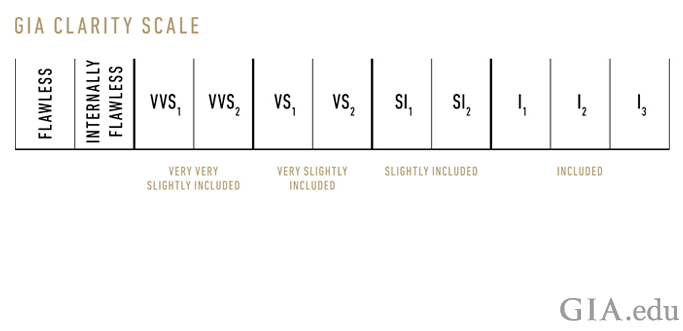
A scale showing a range of diamond clarity ratings from “Flawless” to “Included”. Photo Credit: GIA
The first diamond clarity tier on the chart is Flawless (FL) and internally flawless (IF). Flawless (FL) diamonds have no internal inclusions and no blemishes at all. They sit on pillows in museums! In fact, flawless (FL) diamonds are so rare that once set in a piece of jewelry, the stone loses its flawless grade. Because diamond experts assume setting a stone blemishes it, after setting, a flawless diamond becomes internally flawless. In other words, internally flawless (IF) stones are totally free from internal inclusions of any kind, but may have a small nick, scratch, or extra facet to identify it.
The next tier down on the clarity scale is VVS (which means “very very slightly” included – we kid you not. These gems have “very very” tiny inclusions, which are difficult for even a trained gemologist to spot under a microscope. VVS1 diamonds may have a single pinpoint under 10x magnification. In comparison, VVS2 stones may have a few pinpoints or tiny crystals.
Inclusions in VS stones are still very small, even under magnification. These inclusions are easier to spot by a trained eye, but cannot be seen without a microscope. VS1 stones may have a few small crystals, whereas VS2 stones begin to show more variety in inclusions and may possess tiny feathers, clouds, and/or crystals.
SI stones are the last tier of the diamond clarity chart in which diamonds can be clean to the naked eye. SI1 diamonds have inclusions which are likely visible to the untrained eye under 10x magnification. Comparatively, SI2 stones may have inclusions which are visible to a discerning naked eye – but likely would require magnification for others.
The European Gemological Laboratory (EGL) invented the clarity grade “SI3.” The rest of the diamond industry does not recognize SI3 grading. So, if you are currently looking at a diamond with an SI3 grade, you should consider the stone a GIA I1 or I2.
Diamonds that fall in the I1-I3 clarity chart tier have visible inclusions without a microscope. I1 clarity have the least amount of eye-visible inclusions, whereas I2 diamonds have very visible inclusions. I3 diamonds are the lowest clarity grade possible prior to industrial drill bit use. As the inclusions present in I1-I3 diamonds detract from the beauty of the gems, Do Amore does not sell them.

A diagram showing a range of diamond clarity grades. Photo Credit: www.whiteflash.com
While they are the rarest, diamonds with clarity grades of FL, IF, and VVS are very expensive. As a result, you can get a lot more value by purchasing a diamond graded VS2 or SI1. These gems are beautiful, typically eye-clean, and will save you some money. Above all, to your fiancée’s naked eye, there will be no difference between a flawless diamond and an eye clean VS2 or SI1 diamond of equal size, cut, and color! For this reason, stones graded as a VS2 or SI1 on the clarity scale are best value when considering a diamond’s clarity.
Eye clean diamonds are stones in which no inclusions or blemishes are visible to the naked eye. Diamond experts typically use the term “eye clean diamond” when discussing VS2 and SI1 clarity grades for brilliant cut diamonds (such as rounds, ovals, and princesses), and VVS1 and VVS2 clarity grades for step cuts (such as emerald cuts and assher cuts.) Consequently, “eye clean” means that even though the diamond does have inclusions visible under magnification, you will not see them without it.
Probably not. While diamond clarity is important, most couples today state that ethical sourcing and beautiful design play a larger role in their engagement ring. The majority of couples we work with prefer a larger eye-clean diamond over a smaller flawless diamond. Choosing an eye-clean diamond instead of a flawless diamond gives you the most value. So unless your partner has specifically requested a FL, IF, or VVS stone, odds are they’re not expecting one.
Diamond clarity grading takes place under 10x magnification and daylight-equivalent lighting. In addition, diamonds are graded “face-up,” the same way a diamond is set in jewelry. This is because inclusions look larger and more noticeable face-down, and clarity is a relative grade. The less noticeable a diamond’s inclusions are, the closer to flawless it will grade.
The size of a diamond will affect its clarity grade. For example, a large diamond may have a small, but eye-visible, inclusion yet still receive a high clarity grade. This is because the inclusion is relatively small in comparison to the size of the stone. A smaller stone with the same size inclusion would receive a lower clarity grade, given the inclusion’s size relative to the smaller stone.
The cut and shape of a stone can also affect the stone’s clarity grade. This is because certain shapes, such as emerald cut and asscher cut, do not mask inclusions. Emerald and asscher cuts have long, mirror-like cut patterns called “step cuts” which are intended to show off high clarity and color grades. Inclusions, if present, are more visible in these stones than “brilliant cut” gems like rounds, pears, and ovals. So, if you are considering an emerald cut or an asscher cut diamond, in order to ensure your stone is eye clean, you should consider diamonds graded VVS1 or VVS2 on the clarity chart.
In brilliant-cut stones, the diamond’s cut pattern (its “facets”) creates sparkle! If an inclusion is well hidden by the sparkle of its facets, it will grade higher on the scale. Likewise, if the cutting quality is poor, inclusions may be more noticeable, resulting in a lower clarity scale rating. So, if you are considering a round, oval, pear, heart, cushion, radiant, marquise, or princess cut diamond, look for eye clean stones in grades VS2 and SI1.
Before you go, let’s talk about sources of information. Although there are many gem labs out there that grade diamonds (GIA, IGI, EGL, AGS, and a bunch of “in house” certifiers) they are not all created equal! This post discusses GIA clarity grades, which are the industry standard. Because of this, GIA is the most trusted gemological lab, and grades diamonds with the strictest ethics.
Sadly, many other labs do not grade as strictly as GIA which results in customers buying upgraded stones. Upgrading occurs when a diamond that GIA would grade lower on the clarity scale is graded much higher by a less reputable gem lab. For example, a GIA I1 may be graded by another lab as an SI1. Don’t let them fool you! An upgraded report cannot magically make a diamond a higher clarity grade, or more valuable. Because we strive for complete transparency and want the best for our customers, Do Amore only sells GIA-certified natural diamonds. This ensures that you get exactly what you pay for.
Yes, I would love to! I can do a custom search to help you hand-select the perfect eye clean stone for your special engagement and make sure the diamond clarity is ideal. Email me here or send us a note here, and tell me a bit about what you’re looking for and I will email you back a personalized selection of diamonds! Or, alternatively, check out the recommended diamonds I have selected based on gemologist confirmed eye-clean clarity, ideally cut proportions, and utmost bang for your buck!

A couple showing off their new engagement ring. Photo Credit: Jasmine Wallace Carter
Verifiably Ethical & Sustainable
Guaranteed 1:1 Impact
Personalized 1:1 Customer Service
handcrafted & american-made
you before us, always
Diamonds, Gemstones, & Metals
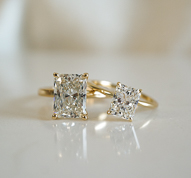
Every piece of Do Amore jewelry begins by not hurting the world. All our natural diamonds are either ethically sourced in Canada, recycled to eliminate additional demand, or accompanied by a blockchain ledger showing every hand your diamond passed through, proving your stone is truly conflict-free.
We also offer sustainable lab-created stones and guarantee all precious metals are recycled to eliminate the environmental impact of mining. Since March 2022, we carry absolutely no Russian diamonds and continue to urge the industry to follow suit.
Clean Water
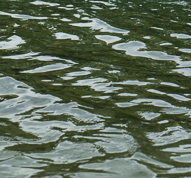
We desire to deepen the well of love in the world. We guarantee that every single purchase—whether engagement ring, wedding band, or piece of jewelry—directly impacts one person’s life by giving them access to clean water.
We do this by directly matching jewelry purchases to people in communities to ensure our funding has a one-to-one impact. We also show you the exact GPS coordinates and a photo of the water well your ring or piece of jewelry helped fund.
Customer Service
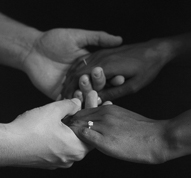
As a small, 100% founder- and employee-owned team, one-to-one encounters are at the heart of our values. Whichever way you want support throughout your engagement ring or jewelry purchase process, our team is here to accommodate you.
From high-touch to hands-off, video calls to text messages, you have our dedicated, responsive team on your side from the moment you start your search, to the day your well is built, to the time we meet again.
Engagement Rings, Bands, & Jewelry
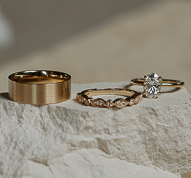
Every Do Amore design, whether one of our own or unique to you, is beautifully handcrafted in America and made specifically for you. Each ring is made to order, every time.
From classic to custom, you have the option to select from dozens of gorgeous settings or work with our design team to create something entirely bespoke. Plus, you are always covered for free inspections, polishing, cleaning, stone tightening, rhodium-plating, and resizing for life.
Our Promise

We care about what matters most to you, not what’s easiest for us. If it’s a minor change to a setting or arriving at a completely custom design, we work to ensure you get precisely what you love.
From statement-making to understated, we have options at any price point. Plus, you always have our team on your side searching to bring you every stone within your specifications. We also offer 30-day returns and a limited lifetime warranty to cover you in the rare event of a manufacturing defect.